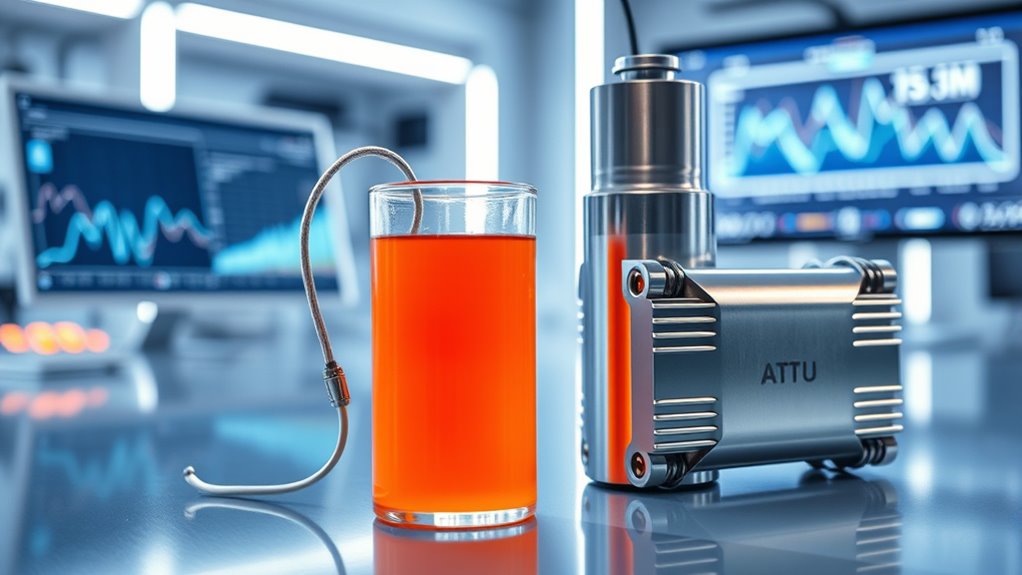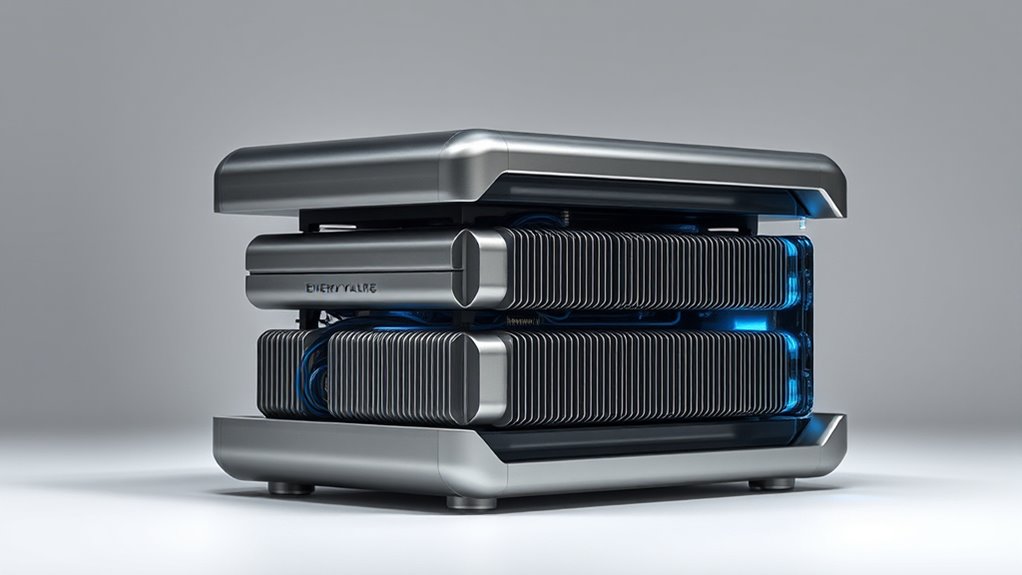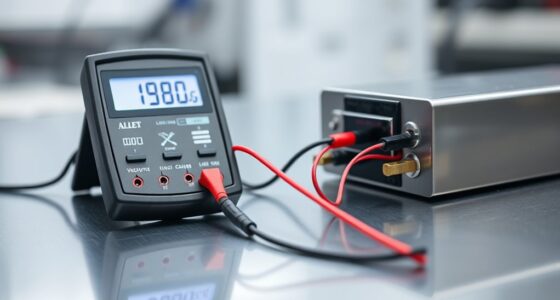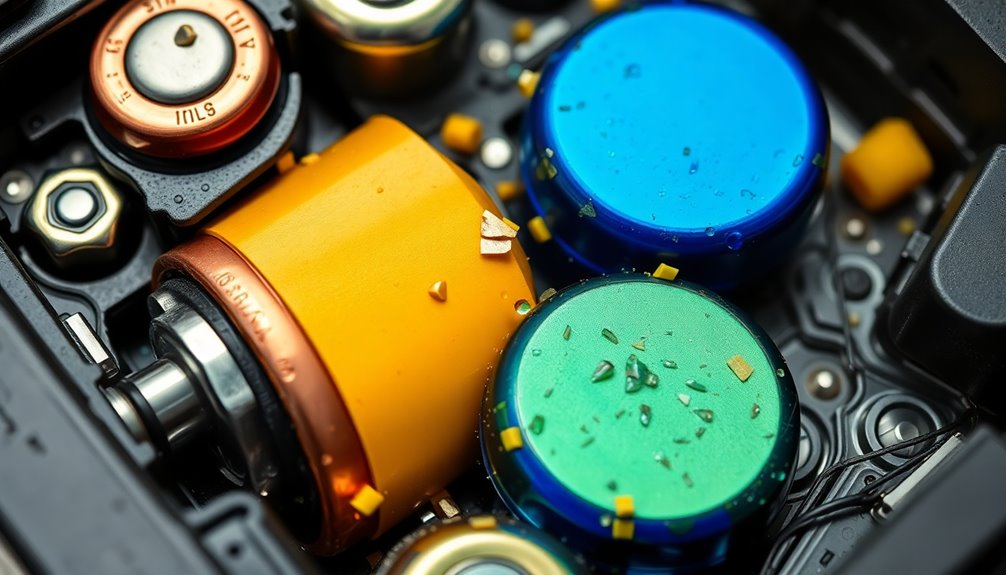Hybrid energy storage combines batteries and supercapacitors to enhance power management in renewable systems. You get the benefit of batteries storing energy for longer periods, while supercapacitors provide instant bursts of power during sudden changes. This mix helps stabilize the grid, improve efficiency, and reduce reliance on fossil fuels. If you want to learn how this innovative approach optimizes energy systems and supports a greener future, keep exploring further.
Key Takeaways
- Hybrid energy storage merges batteries’ high energy density with supercapacitors’ rapid charge/discharge for optimal performance.
- Combining both technologies enhances grid stability by quickly responding to power fluctuations and smoothing renewable output.
- Hybrid systems extend component lifespans by distributing load, reducing stress on individual energy storage devices.
- They improve overall efficiency in renewable energy integration, supporting sustainable and reliable power supply.
- Technological advances are making hybrid storage systems more cost-effective, scalable, and vital for future energy resilience.

Have you ever wondered how modern energy systems manage to store and deliver power efficiently? The answer lies in hybrid energy storage solutions that combine the strengths of different technologies. By integrating batteries with supercapacitors, these systems can address the unique demands of renewable integration and maintain grid stability. Renewable energy sources like wind and solar are intermittent, producing power unpredictably. To keep the grid stable, energy storage must be quick to respond and capable of handling sudden fluctuations. That’s where hybrid systems shine—they blend the high energy density of batteries with the rapid charge and discharge capabilities of supercapacitors.
Hybrid energy storage combines batteries and supercapacitors for efficient, rapid, and reliable power delivery.
Batteries excel at storing large amounts of energy over longer periods, making them ideal for smoothing out the supply from renewable sources. They can absorb excess energy when production exceeds demand and release it when needed, ensuring continuous power delivery. However, batteries often struggle with fast, high-power surges, which are common during sudden changes in renewable output or grid demand. Supercapacitors step in here. They can charge and discharge almost instantaneously, helping to stabilize the grid during quick power swings. This quick response time is vital for maintaining grid stability, especially as more renewable sources are added to the mix.
When combined, these two technologies create a hybrid system that maximizes efficiency and reliability. The supercapacitor handles rapid fluctuations, preventing frequency drops or surges that could destabilize the grid. Meanwhile, the battery manages more sustained energy storage, balancing supply and demand over longer periods. This synergy not only enhances grid stability but also improves the overall performance of renewable integration. With such systems, utilities can better accommodate the variable nature of renewables, reducing reliance on fossil fuel backup generators and lowering emissions.
Implementing hybrid energy storage also offers economic benefits. It reduces strain on the grid, minimizes power outages, and extends the lifespan of individual components by sharing the load. As energy demands grow and renewable integration accelerates, these systems become indispensable. They provide a scalable, flexible solution that meets the evolving needs of modern grids. By intelligently combining batteries and supercapacitors, you get a system that responds swiftly to changes, stores energy efficiently, and keeps the lights on without compromising sustainability goals. Essentially, hybrid energy storage is paving the way for a cleaner, more resilient energy future—one that balances technological innovation with the pressing need for reliable, renewable power. Additionally, advances in energy storage technology continue to improve the efficiency and cost-effectiveness of hybrid systems, making them more accessible for widespread deployment.
Frequently Asked Questions
How Do Hybrid Energy Storage Systems Impact Overall Cost Efficiency?
You’ll see that hybrid energy storage systems boost cost efficiency by reducing overall costs and enhancing performance. By combining batteries with supercapacitors, you cut down on the need for frequent replacements, which lowers maintenance costs. Additionally, the system’s efficiency improves, allowing you to store and deploy energy more effectively. This synergy results in long-term savings, making your energy management more economical and reliable overall.
What Are the Primary Challenges in Integrating Batteries With Supercapacitors?
You face challenges like voltage compatibility and thermal management when integrating batteries with supercapacitors. Ensuring both components operate at compatible voltages requires careful circuit design, while managing heat generated during rapid charge and discharge cycles is vital to prevent damage. Balancing these factors demands advanced engineering and precise control systems, making integration complex but essential for optimizing hybrid energy storage performance and lifespan.
How Long Do Hybrid Energy Storage Systems Typically Last?
Hybrid energy storage systems generally last between 10 to 15 years, depending on usage and maintenance. You’ll benefit from good lifecycle durability if you perform regular maintenance and monitor both batteries and supercapacitors closely. Proper management minimizes degradation, extending system longevity. Keep an eye on performance metrics, replace components as needed, and follow manufacturer guidelines to maximize lifespan and ensure reliable energy storage over time.
Can Hybrid Systems Be Scaled for Large Industrial Applications?
You can absolutely scale hybrid systems for large industrial applications—they’re like powerhouses ready to handle massive energy demands! With proper system integration and advanced design, these systems can be customized for any industrial scale. Their flexibility makes them ideal for boosting energy efficiency, managing peak loads, and ensuring reliable power. So, yes, hybrid energy storage solutions are highly adaptable, capable of meeting the complex needs of large industries with ease.
What Are the Safety Considerations for Hybrid Energy Storage?
You should prioritize safety by managing fire hazards and ensuring proper thermal management in hybrid energy storage systems. Regularly inspect for overheating, worn components, or damaged insulation to prevent fires. Implement effective cooling solutions to control heat buildup, and follow strict safety protocols during installation and maintenance. Staying vigilant about these safety considerations minimizes risks and keeps your hybrid system operating reliably and securely.
Conclusion
By blending batteries with supercapacitors, you’re gently steering toward a future where energy storage becomes more balanced and reliable. This hybrid approach subtly addresses many limitations, offering a smoother, more versatile solution without calling too much attention to any shortcomings. As you embrace this technology, you’re quietly paving the way for smarter, more efficient energy use—an elegant step forward that hints at even brighter innovations ahead.










